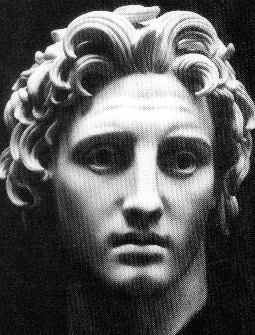By B. John Zavrel
By B. John Zavrel
The 'presidential sculptor' Kurt Arentz with the founder of the Museum of European Art, Consul B. John Zavrel and the former German President Johannes Rau in Berlin.
New York (mea) In 2008, the Town of Clarence will celebrate the 200th anniversary. It is a suburb of Buffalo, New York and only a short drive from the world-famous Canadian side of the Niagara Falls and Canada's largest metropolis, Toronto.
On this occasion, the Museum of European Art has undertaken an ambitious project: the construction of 'Sculpture Garden Alexander the Great' at the Museum of European Art.
The center of the sculpture garden is formed by a ring of pedestals set up in a classical arrangement, reminding of antiquity. On the pedestals will be installed portraits in bronze and marble of 16 important personalities of our time, who were or are Members of the Alexander Order and the Museum of European Art.
The Alexander Sculpture Garden at the Museum of European Art, now under construction. The photo shows the project in November 2006. It is planned to open to the public in 2008.
In the center of this unique collection of portraits will be placed a bust of Alexander the Great.The prominent European sculptor Kurt Arentz has already donated several busts. Portraits of Salvador Dalí and Gala Dalí have been promised by another artist.
For the financing of the Alexander Garden project, donations are sought not only from the United States, but also from Europe and other countries around the world. In addition, the Museum welcomes suggestions and ideas regarding the establishment and use of this garden, which will be accessible to the public.
Without art, there is no culture
The young people are full of energy, ideas and plans for the future. But as one get a bit older, throughts about one's life achievements start to emerge, and with them the question of 'What will be left behind, when I leave this world? Has my life-work made people and the world around me a little happier, healthier, more peaceful, beautiful and nobler?'
If one has been blessed with success and prosperity in one's life, he or she can make a substantial donation during one's life, or in the last will, to a worthy cause. And there are many: the fight against cancer, heart disease, alcoholism and drugs, violence, war, corruption and many other evils that plaque the human society. Or one can choose to support a promising young artist or writer, a future inventor, or the construction of a hospital, a school or a research facility.
But why should one consider an art museum?
Art is the essential justification for being or existence. Without art, there is no culture; without culture there is no reminder of the development of peoples, cultures, settlements, and countries.
Nowadays, many art galleries have turned away from the realistic, representational art and have become filled with meaningless, ugly and ridiculous 'artworks', which impress only the well-paid curators and art critics. The public in general does not care for this kind of 'modern art', but they have no say in the matter, and their interest in visiting modern art museum dwindles from year to year.

In the center of the Alexander Sculpture Garden will be placed a marble bust of Alexander the Great. This is the main idea: the human being is the object worthiest of being depicted in art and, of course, in its perfect harmony of the triad of the body, spirit, and soul.
The human being is the greatest miracle of creation
Fortunately, in the history of mankind, the image of the human being continues to recur as an important motif for artistic depiction. The human being is the greatest miracle of creation. It is, therefore, also the worthiest thing there is to be valued in art.
What is great art? The development of abilities to depict in art makes fundamental statements also about the development of man himself. An ancient cave drawing, for example, may seem "primitive" to the casual observer today. The depiction of an animal, of a hunting scene, and then the depiction of a human figure in a cave--these are nonetheless messages from our ancestors.
In the words of a sculptor-friend of mine, one can say this: "the moment when a human being had the idea and ability for the first time to create such a "work of art" was so stirring and of such great importance to the whole further development of the human intellect and human abilities, that the first landing on the Moon and the flight into space in reality began at that time".
A donation or bequest would be a great help
For the Museum of European Art and its future 'Alexander Sculpture Garden', the human being is the object worthiest of being depicted in art and, of course, in its perfect harmony of the triad of the body, spirit, and soul.
If you agree with our philosophy of what is great art, and would like to support a young, growing and ambitious art institution, do consider making a donation to support our work. Also bequests in one's last will of money, artworks or other assets would be of greatest significance for the long-term success of our cultural engagement.
The Museum is a not-for-profit educational organization, and donations are fully tax deductible. Contributions can be sent to: Museum of European Art, 10545 Main Street, Clarence, New York 14031, USA. For more information, contact zavrel@meaus.com
© PROMETHEUS 115/2007
PROMETHEUS, Internet Bulletin - News, Politics, Art and Science. Nr. 115, January 2007